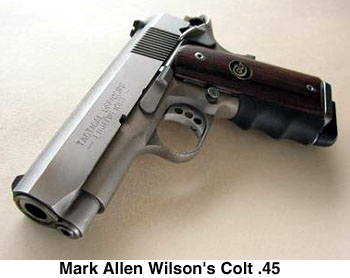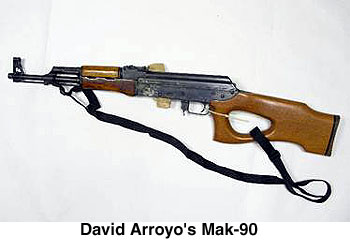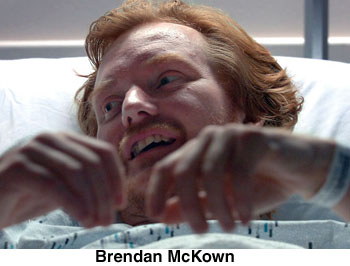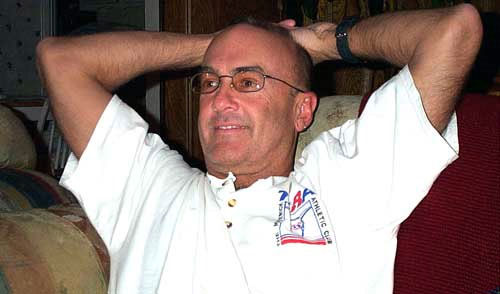A Tactical Analysis of the Tyler Courthouse Shooting and the Tacoma Mall Shooting
By Syd

For the second time this year, a legally armed citizen armed with a pistol faced a crazed gunman armed with a rifle and did not prevail. In February 2005, Mark Wilson engaged David Arroyo on the steps of the courthouse in Tyler, Texas. Arroyo was wearing body armor and was armed with a Mak-90 7.62x39mm rifle. While Wilson was able to land hits from his .45 pistol on Arroyo, Arroyo’s body armor stopped them and Arroyo was able to kill Wilson. On the 20th of November, at a shopping mall in Tacoma, Washington, Dominick Maldonado opened fire on shoppers with a Norinco Mak-90 rifle. Maldonado, who at the age of 20 already had an extensive arrest record, had been taking methamphetamine for five days. He decided to take out his “rage” against the world by shooting complete strangers. A legally armed citizen, Brendan McKown, chose to intervene. He drew his 9mm pistol but did not fire. Instead, he verbally ordered Maldonado to put down his gun. Maldonado responded by firing four rounds into McKown’s torso. McKown survived his wounds but was grievously injured including a hit to the spine which may leave him unable to walk. Both Mark Wilson and Brendan McKown are the finest kind of people, heroes in truest sense. I would be proud to call either man my friend. Nevertheless, both men were shot and did not succeed in stopping the bad guy in their engagement. The good guys got shot and the bad guys walked away.
These incidents raise troubling questions. This is not the way things are supposed to go. The good guys are supposed to come out on top, or at least they shouldn’t lose their lives or become paralyzed. Were these outcomes simply fate, or could things have been done differently and a different outcome obtained? How do our ethics and religious principles affect our tactical decisions? And most importantly, are there lessons which can be learned from these incidents that could improve the outcome of a similar encounter in the future?
Analysis of these two fights runs the risk of criticizing two brave men who I consider to be heroes, and it’s my hope to avoid “Monday morning quarterbacking” although some of that will be necessary. Everything said here is in the context of deepest respect and appreciation for the sacrifices these men made.

Firepower
It’s an interesting coincidence that in both of these incidents the bad guy was armed with a Mak-90, a semi-automatic AK-47 clone chambered in 7.62x39mm. This is a formidable weapon. At first glance, it would be easy to say, “Well, duh. Rifle trumps pistol. End of story.” Closer examination, however, would suggest that the rifle versus pistol matching made less difference in the outcome of these incidents than the first glance might suggest. Wilson landed body hits on Arroyo before Wilson was shot but the body armor worn by Arroyo stopped the bullets. A rifle capable of punching through body armor would have been of great benefit to Wilson in countering Arroyo. McKown did not fire his weapon so the comparison of guns is irrelevant. Maldonado was willing to shoot and shoot fast whereas McKown was not. At the range that Wilson first engaged, about 40 to 50 feet, the rifle wielded by Arroyo might have been an advantage, but the fatal shots fired by Arroyo were fired at close range when Arroyo came around the truck behind which Wilson had taken cover. The fatal shots were fired at point blank range. McKown engaged Maldonado at approximately 20 feet; so again, the rifle’s advantage at range is irrelevant.

Ethics and Religious Principles
The issue of ethics and religious principles comes into play at two distinct junctures in these incidents. The first is the deeply felt obligation to defend the innocent and the second is the Christian affirmation of the sanctity of life.
Both of these brave men chose to engage voluntarily. They were not personally under an immediate threat. Mark Wilson was in his apartment when he heard gunfire. His apartment had a clear view of the courthouse steps so he could see what was happening before he grabbed his Colt and went into the street to intervene. McKown was in another shop when he heard gunfire and went toward the sound to try to stop the mayhem. Both men could have opted to stay where they were and would have remained safe, but they chose to do otherwise. A hard-nosed, pragmatic analysis viewed from the perspective of personal survival would say that the wisest course of action would be to take cover and stay safe. Another CCW holder at the Tacoma mall who was there with his family chose to get his family to a safe place behind cover and defend them, but not to engage the crazy shooter. Had I been there with my family, I’m sure that I would have made a similar choice on the basis that my first obligation would be to defend and protect my loved ones.
It is clear in both cases that Wilson and McKown felt a moral obligation to intervene to save the lives of complete strangers, and they did. For guys like McKown and Wilson, simply taking cover and protecting themselves is not an ethically acceptable response. The clearest tactical judgment would tell us to take cover and defend ourselves, but there are times when our ethical convictions supersede our better tactical judgment.
McKown is the progeny of a deeply committed Christian family. His parents are involved in a prison outreach ministry, and he shares their convictions. By his own report, when he looked at the boyish Maldonado, he could not bring himself to take the shot. Instead, he chose to draw his gun and attempt to command Maldonado to drop his gun. (There is some confusion about what happened next. Some reports have McKown re-holstering his pistol and attempting verbal commands. Another report said that when the CZ pistol was found it appeared to have fired one round and then suffered a “double-feed.” McKown’s own report is not clear about this. At one point he says that he couldn’t fire at Maldonado because he looked like a kid and at another point he relates his attempt to crawl after Maldonado after he was shot because “I missed him.”) Maldonado’s response was to spin around and put four rounds into McKown’s torso. McKown’s compassion and respect for human life had prevented him from taking the shot on Maldonado, even though Maldonado was already firing and had shot people. God bless McKown, and I’d love to have him for a next door neighbor. However, the cold tactical analysis would suggest that the most effective course of action would be to take the shot when he had it, and make no attempt to verbally confront or command Maldonado.
Criminal Psychology
For the purposes of this discussion, I will divide those who criminally use firearms into two broad categories: rational criminals and crazy shooters. I am aware that other categories could be suggested such as thrill killers, “crimes of passion” and terrorists, but those aren’t particularly relevant for this analysis. By “rational criminals” I mean the folks whose basic “job” is some kind of crime, such as stick-up guys, burglars and dope dealers. While they may suffer from poor judgment and other character flaws, they are relatively “sane” and rational. They use their firearms as tools of the trade and only employ them to coerce and intimidate others or to defend themselves. These folks tend to react in more or less predictable and rational ways, and their responses can often be anticipated. If they’re cornered and you have the drop on them, they are more likely to surrender and cease their behavior, since, like other rational people, they don’t want to be shot and they know they can go to jail, call their lawyer, and be back out on the street in a few hours. If they aren’t cornered, they will flee – a rational response to the instinct for self-preservation. This is not to say that you should ever let your guard down, but with the rational criminal you have at least a common basis for communication and expectations.
The “crazy shooter” is a different breed of cat. He may be truly psychotic and hallucinating, very high on drugs, or in some other way distressed and no longer operating in a rational framework. His responses cannot be anticipated. He may be insensible to pain because of drugs and/or suicidal. He may be hoping for a “suicide by cop.” The values of the crazy shooter are totally different from those of rational people, and rational people are rarely able to empathize with or understand a crazy shooter without advanced professional training. He is a failed personality who has run out of options. These folks almost never have a realistic exit strategy for the situation because most often they are not really planning to live through the encounter.
Both Maldonado and Arroyo fall into this second category of crazy shooters. Maldonado has a long felony rap sheet and had been taking methamphetamine for five days prior to his shooting spree. Arroyo was perhaps more rational and capable of planning but he was ultimately suicidal. In the midst of a contentious divorce, he went to the courthouse to kill his ex-wife and his own son. He put on body armor which demonstrates planning, but the expectation that he could just get into his pickup and drive away shows that he was not thinking rationally and did not really expect to survive the day. He was stopped by the local police on his way out of town and killed in an exchange of gunfire with them.
When McKown ordered Maldonado to put down his gun, he was relating to Maldonado as if he were a rational criminal, but Maldonado was a crazy shooter, high on methamphetamine, and operating on a set of values which are totally alien to rational people. Our tactics must be appropriate for the adversary we face. It is safe to assume that a person standing in a public place and shooting total strangers is a crazy shooter and will not respond in rational ways. For a rational criminal, just the sight of a gun may dissuade him from further action, although you can’t count on that. With a crazy shooter, an “enemy” to shoot it out with may be just what he’s looking for.
Movement, Cover and Marksmanship
One factor that was present in both cases is that neither Wilson nor McKown were moving at the time they were shot. McKown went into a fixed stance with his gun drawn and issued verbal commands. He was in an open area of the store and there was no hard cover available to him. Wilson went prone behind a pickup. Witness Nelson Clyde III said that Wilson was hit and then went down into the prone position. Arroyo then came around the pickup and delivered the fatal shots. This is a report from a friend of Mark’s, Robert Langham, who viewed the courthouse security camera tape:
“Mark had heard the boom of gunfire from his loft apartment overlooking the Spring Street side of downtown Tyler… A glance out his windows would have shown the scene completely: the gunman advancing, the victims sprawled on concrete. Mark grabbed his Colt, bounded down the staircase to the sidewalk, crossed the corner intersection and sprinted to cover behind the first vehicle on the end of the block… David Arroyo was at that moment stepping forward to finish killing his own son on the courthouse steps… Mark lined up the sights on the gunman’s bulky back. He shot once, perhaps twice. The range is inside 20 yards. Less than 60 seconds had passed since he heard the first shot… Mark Wilson was in street, firing. The courthouse security camera shows Arroyo turning away from his son bleeding on the steps and running back to his truck… On camera, three sheriff deputies in the courthouse door began to fire steadily. Mark shoots again to no effect. The gunman is wearing an army flak jacket over body armor. Pistol shots will not penetrate… Wilson and Arroyo exchange shots across the truck bed popping up and down, perhaps three shots each before Mark falls to the red bricks, face down. Arroyo walks around the end of the truck, steps over him and shoots repeatedly…”
It’s hard to find fault with Mark Wilson’s performance that day from a tactical viewpoint, nor is that my desire. Wilson did almost everything right. It’s tragic that he couldn’t accomplish a head shot, that he didn’t grab a rifle to start with or retreat when Arroyo began to move toward him. If, if, if. If frogs had wings, they wouldn’t bump their butts when they hop. These are the facts and the fact is that Arroyo landed a disabling shot before Wilson did. It should be noted that, against a rifle such as an AK, the bed of a truck is concealment but it is not hard cover. An FMJ 7.62x39mm round will shoot through the bed of a truck.
What Can Be Learned Here?
“The faster you shoot, the less shot you will get.” – Jim Higginbotham
Act decisively. When your internal “go” signal is tripped, don’t hesitate. He who hesitates loses.
Use hard cover when possible. Learn the difference between hard cover and concealment.
“Hard cover” is a barrier that will stop bullets and protect you from incoming fire. “Concealment” is a barrier that hides you from the adversary but does not stop bullets. Weapons like the AK-47 will penetrate most building materials. They will also penetrate car bodies.
Move!
Moving targets are hard to hit. Especially when hard cover is not available, keep moving. Retreat is an honorable strategy. “He who fights and runs away lives to fight another day.” Practice shooting on the move, the faster the better.
Do a “gut check”
Are you really able and willing to pull the trigger on another human being? If you aren’t, don’t draw a gun on someone who is. I have talked to a number of people who choose not to carry a firearm for personal defense. Almost without exception, the reasons given are, “I just don’t think I could do it,” (meaning, “I can’t shoot someone.”), or “It would probably just get me in trouble,” (Meaning, “I don’t feel competent to fight with a firearm.”). I respect that position and I respect that level of self awareness. If that is your personal truth, then find other means and strategies for self-defense. On the other hand, no right thinking human being ever wants to shoot another, and being repelled by the idea does not necessarily mean that one would be incapable of armed self defense faced with a real threat. But in all things, “Know thyself.” Many folks seem to subscribe to a notion that I have come to call “The Magic Talisman” theory of pistolcraft. They seem to believe that somehow simply brandishing a handgun will solve the problem and make the bad guy act right. It might and it might not. The reality is that pistols require skill, training, and self control to employ effectively. If you draw it, be prepared to fire.
“A man’s got to know his limitations.” – Dirty Harry
Despite some of our negative stereotypes about police officers, most police officers have years of specialized training that the rest of us don’t have. Police officers will always appear more tentative than we might like in situations such as the Tacoma mall because they are trained to gather as much information as possible before acting. They know that sometimes bad guys set bombs and lay ambushes. They have to determine how many bad guys there are, their locations, if there are hostages and the locations of possible hostages. Many have seen colleagues fall because they didn’t have adequate information or backup. Armed citizens are not police officers, but sometimes it pays to take a cue from the way law enforcement approaches these kinds of situations.
Know what you can do. Know what your gun can do. Know what you can do with your gun. A fight is a terrible venue for new product testing.
Practice hard shots
Practice shooting from weird positions. Practice weak hand shooting. Practice for head shots. Practice on moving targets if possible. Practice malfunction clearances. Practice emergency reloads. Practice everything. Practice a lot. Get some training. Ammo is cheap and Murphy is alive and well.
Be flexible.
If what you are doing isn’t working, do something else.
“When going to a gunfight, take a long gun and a friend with a long gun.”
Pistols are close quarters self-defense weapons. All pistols are a trade-off of performance for convenience. When you go on the offensive, i.e., attack, all of the shortcomings of the pistol come into play with a vengeance – puny ballistics, limited firepower, limited range and difficulty in achieving accuracy quickly. Despite the silly propaganda from the gun grabbers, no pistols are “assault weapons.” If they were we wouldn’t bother with equipping our soldiers with rifles and machine guns.
Epilogue
I still feel a great reluctance to say anything at all about these two incidents. No matter how carefully one proceeds and chooses his words, commenting on the sacrifices made by McKown and Wilson still feels disrespectful. My reluctance to talk about these incidents was only overcome by the idea that lessons should be learned and by doing so we honor the fallen and make their sacrifices more significant by applying their lessons to the next incident that may arise.
I have tried to avoid using the language of “winning” and “losing” in reference to Wilson and McKown because winning and losing is not a simple matter in these incidents. McKown and Wilson did what they felt they had to do. They were true to themselves, and both men saved the lives of others even though they paid a terrible price. You can’t call getting shot “winning” and you can’t call standing up for what you believe and saving the lives of others “losing.”
Analysis such as this traps us at a point of abstraction. We can’t be there and we can’t get into the heads of the people who were. We can guess and speculate about things which might have been done differently but we cannot re-create the situation in order to test our theories. Ultimately, we are left with our revulsion for the bad guys and reverence for the good guys, fear that we may face a similar test and hope that somehow things will turn out better for us.

Mark Allen Wilson
An American Hero
1953 – 2005
Texas House Resolution No. 740
R E S O L U T I O N
WHEREAS, The tragic death of Mark Alan Wilson of Tyler on
February 24, 2005, at the age of 52, has brought a profound loss to
his many friends and loved ones; and
WHEREAS, With instinctive courage and selfless resolve, this
valorous Texan confronted a gunman on the steps of the Smith County
Courthouse; reacting to the kind of inhuman crisis that compels
ordinary men to seek cover or flee, Mark Wilson proved to be an
extraordinary man; and
WHEREAS, Mr. Wilson confronted a lethal threat in order to
protect the people of his community, and in his valiant attempt to
save the lives of others, he risked his own safety; and
WHEREAS, The magnitude of the sacrifice that ended his life
all too prematurely is in keeping with the character that was
evident to all who knew him; an active member of the Tyler
community, he used his time on earth to the fullest; and
WHEREAS, Born on January 20, 1953, in Dallas, Mr. Wilson
graduated from MacArthur High School in 1971 and went on to serve
his country with distinction in the U.S. Navy; after his discharge
from the military, this avid sportsman worked as a racquetball
instructor and embraced his entrepreneurial spirit, opening
Tyler’s On Target Shooting Range in 1997; and
WHEREAS, A dedicated volunteer, he committed his talents to
help raise money for nonprofit organizations and lent his time to
Heart of Tyler/Main Street projects, including the Texas Blues
Festival and Festival on the Square; and
WHEREAS, Mark Wilson was a true hero, and his example reminds
us that the very best elements of human nature can emerge in the
midst of the chaos and violence that threaten our society; though
this brave man will be missed, his legacy will continue to inspire
all who are privileged to know of him; now, therefore, be it
RESOLVED, That the House of Representatives of the 79th Texas
Legislature hereby pay special tribute to the life of Mark Alan
Wilson of Tyler and extend deepest sympathy to the members of his
family: to his parents, Alex and Lynn Stewart; to his sisters,
Melody and Holly Wilson; to his nieces, Katie and Kristen DeFazio;
and to his other relatives and many friends; and, be it further
RESOLVED, That an official copy of this resolution be
prepared for his family and that when the Texas House of
Representatives adjourns this day, it do so in memory of Mark Alan
Wilson.
Berman
______________________________
Speaker of the House
I certify that H.R. No. 740 was unanimously adopted
by arising vote of the House on March 31, 2005.
______________________________
Chief Clerk of the House
http://www.capitol.state.tx.us/tlo/79R/billtext/HR00740F.HTM

Comments, suggestions, contributions? Let me know